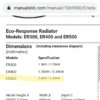You're asking that the wrong way round.
He did get 22Ω.
Therefore if there are three elements and one IS open circuit that means the heater should be 3.6kW - @ 230V.
Although I think the values would be at 240V which would be 3.9kW.
I think that is higher than normal so I would presume the three - or two - are alright.
He did get 22Ω.
Therefore if there are three elements and one IS open circuit that means the heater should be 3.6kW - @ 230V.
Although I think the values would be at 240V which would be 3.9kW.
I think that is higher than normal so I would presume the three - or two - are alright.




